Big Data: Behavioral Insights Boost Profits for Insurers

The insurance industry depends for its very existence on data and calculations of risk that Event X will or will not happen.
As such, it’s perhaps no surprise that the industry is forever seeking more and more data through new and highly technological collection methods, and increasingly accurate ways of translating the collected data into actuarial and statistical likelihoods.
So-called “InsurTech” is a vastly growing market – its value rose from $140 million in 2011 to $4.9 billion in 2018. And in the wake of a global pandemic, it’s safe to assume the need for technology to deliver accurate metrics for insurance has only blossomed.
In 2019, a research report into the importance of technology in the future of the insurance industry found that:
- 79% of insurance executives believed that AI would revolutionize the way their firms produce and deliver their products
- 37%-56% of InsurTech start-ups focused on improving distribution.
- InsurTech was increasing transparency, allowing greater consumer engagement and broadening consumers’ understanding on how their decisions influenced their costs.
- The IoT sector was projected to be worth $1.7T by 2020, and insurers were adjusting accordingly by ramping up IoT initiatives.
- InsurTech solutions were revolutionizing how consumers are engaging with and understanding their policies, increasing participation and mitigation of risk.
Insurance firms spent nearly $225 bn on IT in 2019.
Data-Driven Risk Tables
The notion of InsurTech is dependent on the availability of data, and how that data translates into metrics that can be reliably used to allocate risk, and raise or lower insurance premiums as a result.
On the fundamental principle that everyone lies to make themselves look “better” than they actually are when quizzed about it by professionals, self-assessment is unreliable if that model is going to function accurately. Everything about that model has to do with convincing us to carry what is essentially an activity monitor in the ‘space’ that needs monitoring to provide a certain kind of insurance. Essentially, it depends on us adding an Internet of Things-based state or activity monitor to our lives.
That can include a “black box” being added to our cars to monitor driving behavior, so as to deliver ‘safe driver discounts’ to customers who act in ways least likely to cause insurers to have to pay out on claims. It can include a set of IoT sensors in the home to reduce premiums on home insurance. And now, in the age of advanced wearable health monitors, it can include ‘rewarding’ customers by reducing premiums on life insurance when they regularly adopt a less sedentary lifestyle and get active.
Driving Data
The precise types of data recorded by each sort of InsurTech device obviously changes to suit the needs of the insurer.
If you agree to have a black box fitted in your car, it will essentially capture data about your ‘driving style.’ That means it will measure your journeys in terms of their speed, their smoothness, and – which might be of some concern – the straightforward amount of usage you get out of your vehicle. All this combined creates a picture of your driving style.
If your style is within designated speed limits, smooth and not given to random sharp braking (which could indicate insufficient road awareness), and regular, in terms of not venturing regularly onto unfamiliar roads that might lead to radical changes in driving behavior due to situational uncertainty, you are deemed to have a ‘safe’ driving style.
That makes you less likely to be the instigator or the aggressor in an accident, and so less likely to represent a potential pay-out on behalf of the insurer, so they can afford to give you a discount on your policy, because the data they collect tells them they’re likely to save money by insuring more safer drivers.
Big data drives big savings, for both the driver and the insurer, while the knowledge that driving behavior is being monitored, while traditionally thought of in the West as creepy and invasive, tends to enforce calmer driving habits because no-one wants to lose their safe driver status and be liable for higher premiums as a result.
Home Data
When it comes to home (or commercial property) insurance, we move into a whole other realm of tech-enabled data collection. While vehicular black boxes simply sit there like the ultimate back-seat driver, judging your performance, home insurance data is or can be collected by drone. They can be used to monitor inspections, to ensure that regulation safety devices are installed, that windows, doors and roofs are up to code, etc.
Again, the fundamental principle that people lie to make themselves look better than they are is at play here. Drones don’t lie unless somebody makes them do it. There can also be in-home smart devices (some even supplied by the insurer, like smart doorlocks and doorbells) to make sure that life inside the property is as it has been reported.
If all the data concurs with the picture painted by the insurance buyer, then discounts can be applied to the ‘safe householder,’ on the same principle as the car insurance discounts. The less likely you are to be burgled, or to suffer flood damage or burst pipes – the less likely you are in fact to ever make a claim – the more the insurer can afford to discount the insurance they sell you, driven by the data to the relatively safe conclusion that they’re never going to have to pay out on the policy.
Health Data
Finally, there’s what is probably the most dubious InsurTech to date – healthcare wearables to lower your health or life insurance premiums. The accuracy with which wearables can detect improvements or declines in fitness used to be extremely dubious. Then the Covid pandemic hit the world and reliable meditech became a necessity to avoid spreading the virus.
While commercial off-the-shelf wearables are still mostly for customer-reassurance, higher-spec wearables provided by insurers can now log activity, sleep patterns, heart rates and blood oxygenation, not to mention the number of steps walked in a day.
All this data can help the insurer construct a picture of an ‘active lifestyle’ – and the more active your lifestyle, at least within certain broad limits, the less likely you are to need to claim against your health or life insurance. Again, your premiums go down, but the insurance companies save significantly more by having access to the data that allows them to make much more reliable estimates on the likelihood that they will have to pay out any time soon.
There are arguments that all of this amounts to social engineering by technology, and they’re ultimately quite difficult to refute – the discount driver involves promoting particular pathways of behavior, and discouraging others, so as to maximize insurer profits. But as the result is lower premiums across the board on behaviorally-driven insurance, it’s extremely likely that the public will welcome the new data-driven model of how their insurance works.










